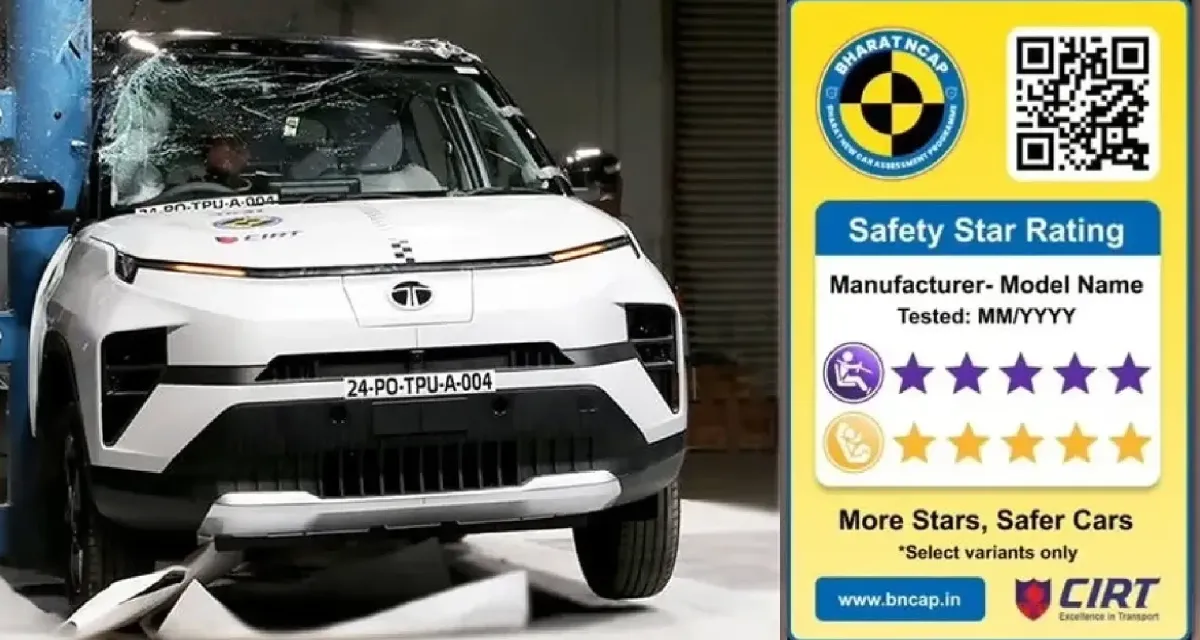
India's New Car Safety Stickers: What You Need to Know

India's New Car Safety Stickers: What You Need to Know
The Government of India has taken a significant step towards road safety by introducing new safety stickers for cars and SUVs that have undergone crash testing under the Bharat New Car Assessment Program (BNCAP). This move aims to raise awareness among vehicle buyers and help them make informed choices by displaying safety ratings prominently on all new vehicles tested under BNCAP norms. But what exactly do these stickers mean, and how will they help consumers?
Bharat NCAP's new safety rating stickers are designed to be simple and informative, ensuring that buyers are well aware of a vehicle's safety standards before making a purchase. The stickers will provide a clear and concise summary of the vehicle's crash test results, making safety information more accessible to the general public.
Each sticker will display key information in a fixed format: the name of the manufacturer, the specific vehicle model, the date when the car was tested, and most importantly, star ratings for both adult and child occupant protection. The star rating system is straightforward, with higher stars indicating better safety performance in crash tests.
What makes these stickers even more valuable is the inclusion of a QR code. When scanned, the QR code reveals a comprehensive report of the crash test results for that particular vehicle. This digital touch allows potential buyers to delve deeper into the safety details, including how the car performed in various crash scenarios, thus enabling a more informed decision-making process.
The introduction of these stickers is a part of India's broader initiative to enhance vehicle safety standards. For years, road safety has been a significant concern in India, given the country's high rate of road accidents. By making safety ratings more visible and understandable, the government hopes to encourage manufacturers to build safer cars and also educate consumers to prioritize safety over other factors like price or aesthetics.
Before the introduction of these stickers, there was little transparency for consumers regarding the safety of the cars they were buying. Now, with the safety ratings made public, it empowers buyers to choose vehicles that offer the best protection for themselves and their families.
Since the Bharat NCAP program was launched in October 2023, the number of vehicles tested under its stringent crash test norms has been limited. So far, only a few SUVs from Tata Motors have undergone these tests, including popular models like the Harrier, Safari, Nexon EV, and Punch EV. All these models have performed exceptionally well, securing a 5-star rating for both adult and child occupant safety. This shows that Tata Motors is currently leading the way in producing vehicles that meet the highest safety standards in India.
There are also rumors circulating in the automotive community that SUVs from other major manufacturers like Maruti Suzuki and Hyundai have been crash-tested by BNCAP. However, the results of these tests have not been made public yet. If these rumors are true, it will be interesting to see how these popular brands fare in terms of safety compared to Tata Motors.
The implementation of these safety stickers is a step in the right direction, but it's only the beginning. The road to making safer cars in India is long, and it requires continuous effort from all stakeholders, including the government, manufacturers, and consumers.
Car buyers in India have often prioritized factors like fuel efficiency, aesthetics, and price over safety. However, with the new safety stickers providing clear and visible ratings, the narrative might begin to shift toward safety as a primary concern. This could eventually lead to a more safety-conscious market where manufacturers compete not just on style or efficiency but on how well their vehicles can protect passengers in the event of a crash.
In summary, Bharat NCAP's introduction of safety rating stickers is a commendable move towards promoting road safety in India. By making safety ratings more visible and accessible, these stickers not only inform but also empower consumers to make better choices. As more cars get tested and more data becomes available, it will push manufacturers to prioritize safety features, ultimately leading to safer roads for everyone.
The success of this initiative will depend on how well it is received by both the public and the automotive industry. If it sparks a shift in consumer mindset towards prioritizing safety, it could herald a new era of safer cars on Indian roads, reducing accidents and saving lives.
Also Read: